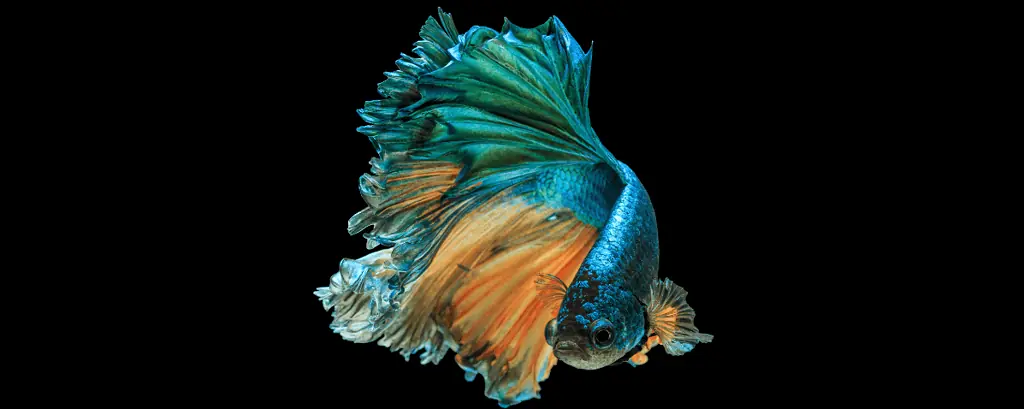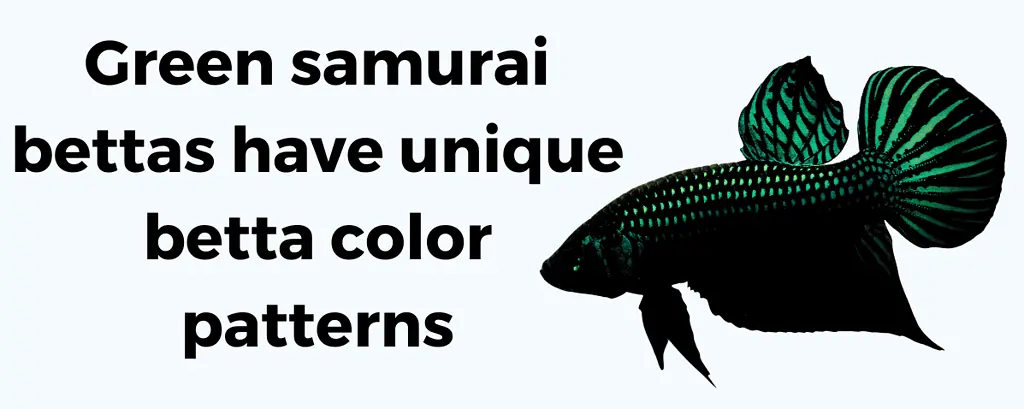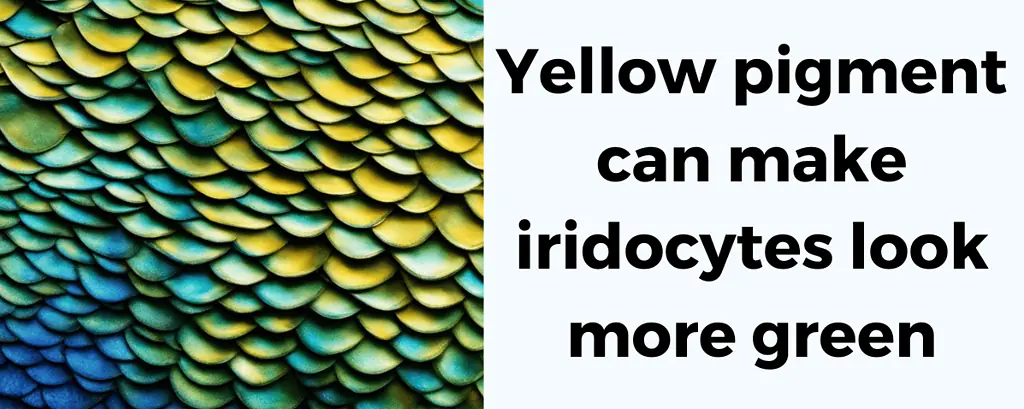Most betta fish connoisseurs are familiar with the more common betta fish colors.
You may find a variety of red and blue betta fish on the pet store shelf.
But have you ever seen a green betta fish?
Chances are, you’ve never come across a genuine green betta.
While green bettas do exist, they don’t have the color of green you might expect.
Let’s discover why green is rare in bettas and explore the genetics of these stunning fish.

Table of Contents
What Is a Green Betta?

Green bettas are not actually green.
Bettas do not have the right combination of pigment cells for producing a true green color.
A green betta has iridescent pigments on its body and fins instead of a green base color.
These iridescent pigments are not pure green but more of a greenish-blue color.
Depending on the light, this green iridescence can range in hue from emerald to mint.
Green bettas usually have other colors on their bodies or fins. Solid green bettas are very rare.
Plakat and halfmoon tail types are the most common in green bettas. But they can have any tail type.
Are There Lime-Green Bettas?
In 2021, a video surfaced of a so-called “Hulk Betta.” The video showed a betta with a lime-green body and fins.
But very recently, someone proved this video to be a hoax. This was the result of alterations through computer software.
Removing the false color layers in the video revealed a betta with the red Hellboy color variant.
Much to the disappointment of betta enthusiasts, this lime-green fish does not exist.
What Is the Difference Between Green and Turquoise Bettas?

Green bettas and turquoise bettas share the same genetics.
The difference between the two is the ratio of green to blue iridescence.
A turquoise betta has equal green and blue iridescent color pigments.
Green bettas have iridescent pigments with more green than blue.
Many people mix up these two betta colors because they appear similar in certain light.
Do Green Bettas Exist in the Wild?
Wild bettas vary in color according to their species.
Some species have dull colors like brown and black. These colors help the bettas blend in with their environment.
The betta coccina has a stunning wine-red coloration.
But two betta species stand out for their metallic green scales: Betta smaragdina and Betta Mahachaiensis.
Betta Smaragdina

The Betta smaragdina earns the name “Emerald Betta” due to its emerald-green color.
It has iridescent blue-green scales, which extend to the gills. The scales create a distinctive spotted pattern, much like a snake.
A Betta smaragdina also has orange accents on its fins and tail.
These fish live in eastern Thailand, Laos, and Cambodia.
Betta Mahachaiensis

The Betta mahachaiensis species has a dark brown or black body. It also has bright green iridescent scales.
The fins have black stripes with green iridescence.
This fish is often confused with the Betta smaragdina. But there are a few differences between them.
A Betta mahachaiensis has a black stripe dividing the mask on its face and more plated scaling.
The Betta mahachaiensis has no distinct body scaling, and the black base color stands out.
Green Betta Color Variations
Breeders have developed several stunning color variations of green bettas.
Most of these color variations are rare due to the difficulty in breeding a green color.
These green betta fish colors are also popular, costing more than other betta varieties.
Green Mustard Gas Betta

A green mustard gas betta has an iridescent green body with yellow or orange fins.
The edges of this betta’s fins are either dark green or black.
This mustard gas color pattern also has blue and black variations.
Green mustard gas bettas usually have the halfmoon tail type. A large, flowy tail showcases the contrast of bright color against the dark body.
Mint Green Dragon Betta

Dragonscale bettas have a unique feature not found in regular betta splendens.
Their scales are white and very thick, giving them the appearance of a dragon.
The mint green dragon betta has a pale greenish-blue metallic color on its body and scales.
A genetic mutation created through selective breeding created these thick, armor-like scales.
As a consequence, mint dragon green bettas can suffer from health issues like blindness as they get older.
Dragonscale bettas usually have the halfmoon plakat tail type.
Mint green dragon bettas are rarer than other dragonscale color variants.
Green Alien Betta

A green alien betta is the result of out-crossing the Betta splendens with the Betta smaragdina and Betta mahachaiensis.
The result is a hybrid betta with a metallic green sheen and black or brown stripes on the fins.
Green alien bettas have the mask trait. This means the betta’s head is the same color as its body.
Unlike green bettas with iridescent genes, green alien bettas do not change color. These fish have a vibrant green color in any light.
A green alien betta usually has a halfmoon plakat tail type with webbing on the caudal fins.
Breeding green alien bettas is very difficult because they do not breed true.
Crossing two green alien bettas results in offspring with a mix of green, steel blue, and turquoise metallic colors.
Some offspring may have a royal blue color without metallic or iridescent traits.
Alien bettas are also available in other color variations, including:
- Turquoise
- Copper
- Purple
- Yellow
This fascinating betta variant is in high demand, so expect a high price tag.
Green Samurai Betta

Green samurai bettas have one of the most unique betta color patterns.
These fish result from a genetic mutation found in the offspring of dragonscale bettas.
Between 40% to 70% of a green samurai betta’s body has metallic green dragon scales.
The rest of the fish is dark black.
A green samurai betta has a distinct line between the metallic green dragon scales and its black belly.
Green samurai bettas usually have a halfmoon tail with distinct metallic green and black stripes.
Are Green Bettas Rare?

Iridescence is common in betta fish. But finding a betta with more green coloring than blue is a rare treat.
Breeders usually focus on producing multi-color green betta variants.
There is a higher demand for these unique color variants than there is for solid green bettas.
Producing these popular green color variants creates more profits for the betta breeder.
While green bettas in any form are rare, you may still find some in your local pet store.
But you’ll have better luck searching for an online breeder for variants like the green alien or green samurai bettas.
Green is more common in wild bettas, but most local pet stores do not sell them.
Again, an online breeder is your best bet for buying a Betta smaragdina or Betta mahachaiensis.
The Average Cost of a Green Betta

The average price range for bettas with a green coloration varies from $25 to more than $65.
A solid color betta is usually less expensive than one with many colors.
Prices for the wild Betta smaragdina or Betta Mahachaiensis are around the same as the domestic green Betta splendens.
If you buy a betta from an online breeder, you must also budget for the shipping costs.
Many breeders offer 2-3 day shipping for around $16.
But remember, this type of shipping does not always come with a live-on-arrival guarantee.
Overnight shipping may cost as much as $40, but it usually ensures you receive a healthy betta.
Breeders also recommend ordering your betta when the weather is mild in your area.
Shipping a betta in temperatures higher than 90 degrees Fahrenheit is often fatal for the fish.
Some breeders offer optional heat packs when shipping bettas in cooler weather.
But this does not always guarantee a safe transit for your betta when temperatures are below freezing.
Always read a breeder’s shipping and return policies before buying a betta.
The Breeding History of Green Bettas

This discovery of green variations in domestic betta splendens dates back to 1934.
Researchers did several breeding experiments to learn more about bettas’ pigment cells and color layers.
Most of the domestic green bettas you see came from outcrossing the Betta splendens with wild-type bettas.
According to research by Dr. Gene Lucas, bettas with green iridescence and black pigment cells have a more pronounced green color.
Without the black pigment cells, the green iridescence in bettas has more of a turquoise hue.
Researchers also discovered the presence of yellow pigment cells in green bettas.
There are no single pigment cells for the color yellow in betta fish.
Instead, yellow comes from the lack of red pigment. The non-red gene causes this.
Many breeders refer to yellow bettas as non-red bettas.
Understanding Betta Fish Color Layers
Domestic betta splendens have four color layers:
- Iridescent (Top Layer)
- Black
- Red
- Yellow (Bottom Layer)
Wild bettas have the same color layers but in different order:
- Iridescence (Top Layer)
- Red
- Black
- Yellow (Bottom Layer)
Each layer’s combination of pigment cells determines a betta’s physical color.
Like any other animal, bettas have dominant and recessive genes.
Recessive genes complicate the betta breeding process.
Bettas can pass these recessive genes to their offspring.
If a breeder does not know the genetic history of a breeding pair, they might get a few surprises in the spawn.
Breeding two green bettas does not produce 100% green offspring.
There is usually a mix of green, steel blue, and other colors depending on the recessive color genes the parents carry.
How Color Layers Work Together in Green Bettas

The iridescent color layer plays a vital role in developing green bettas.
This layer contains iridocytes, the blue and green cells controlling iridescence.
Iridocytes are either turquoise, steel blue, or royal blue.
Green bettas have more turquoise iridocytes than blue ones. In different lighting, you may see flashes of blue on a green iridescent betta.
Wild bettas carry a mutated form of iridocytes. These pigment cells create a metallic appearance.
Metallic colors do not change under light exposure as regular iridescent colors do.
Bettas with a green metallic color appear green under any angle of light.
A genetic mutation of iridocytes creates a trait known as spread iridescence.
Spread iridescence places iridocytes over a betta’s entire body and fins.
Since the iridocytes are in the top color layer, they can enhance the colors in the lower layers.
The black layer contains black pigments called melanophores.
Melanophores can enhance the iridocyte layer by contrasting the black and green pigment cells.
Green bettas with melanophores have a darker color than those without.
A betta’s red layer has pigment cells called erythrophores. These pigment cells control the amount of red coloring in a betta.
Non-red pigment cells create an orange or yellow color in bettas.
Researchers believe this yellow pigment can make iridocytes look more green than blue.
The yellow layer does not control yellow pigment. Instead, this layer controls the opaque trait.
Opaque does not always mean white. There are steel blue, green, and royal blue opaque colors.
If a green betta has opaque genes, the fish appears with a pastel mint green color.
Green Betta Fish Care

Providing a safe and clean environment keeps your green betta healthy.
Start with a tank size of 5 gallons or more. This gives your betta plenty of room for swimming.
Next, you must maintain specific water parameters for your green betta.
Bettas are tropical fish and need warm water temperatures between 78-80 degrees Fahrenheit.
Use an aquarium heater to keep temperatures within this range.
An aquarium filter helps remove bacteria and debris particles from the water.
Along with having a filter, you must perform weekly partial water changes.
Partial water changes remove toxins like ammonia and nitrite from the tank water.
Test your tank water weekly. Ammonia and nitrate levels should never go above 0 ppm.
Anything higher than this is harmful to your green betta.
Add plenty of live aquatic plants and decorations to your betta tank.
Live plants help filter bacteria from the water and create a more natural environment.
Decorations provide hiding places and make your betta feel more secure.
Ensure your aquarium decor does not have any sharp edges. These sharp edges can injure your betta and tear its fins.
Check out our ultimate care guide for keeping your betta fish healthy and happy.


